[English] 日本語
 Yorodumi
Yorodumi- PDB-1xiw: Crystal structure of human CD3-e/d dimer in complex with a UCHT1 ... -
+ Open data
Open data
- Basic information
Basic information
| Entry | Database: PDB / ID: 1xiw | ||||||
|---|---|---|---|---|---|---|---|
| Title | Crystal structure of human CD3-e/d dimer in complex with a UCHT1 single-chain antibody fragment | ||||||
 Components Components |
| ||||||
 Keywords Keywords |  membrane protein/Immune System / CD3-epsilon / CD3-delta / UCHT1-scFv / immunoglobulin fold / antibody-antigen complex / membrane protein/Immune System / CD3-epsilon / CD3-delta / UCHT1-scFv / immunoglobulin fold / antibody-antigen complex /  membrane protein-Immune System COMPLEX membrane protein-Immune System COMPLEX | ||||||
| Function / homology |  Function and homology information Function and homology informationgamma-delta T cell receptor complex / T cell anergy / positive regulation of T cell anergy / positive regulation of cell-cell adhesion mediated by integrin / CD4-positive, alpha-beta T cell proliferation / gamma-delta T cell activation / negative thymic T cell selection / positive regulation of CD4-positive, alpha-beta T cell proliferation / alpha-beta T cell receptor complex / positive thymic T cell selection ...gamma-delta T cell receptor complex / T cell anergy / positive regulation of T cell anergy / positive regulation of cell-cell adhesion mediated by integrin / CD4-positive, alpha-beta T cell proliferation / gamma-delta T cell activation / negative thymic T cell selection / positive regulation of CD4-positive, alpha-beta T cell proliferation / alpha-beta T cell receptor complex / positive thymic T cell selection / signal complex assembly /  T cell receptor complex / positive regulation of cell-matrix adhesion / smoothened signaling pathway / dendrite development / Translocation of ZAP-70 to Immunological synapse / Phosphorylation of CD3 and TCR zeta chains / alpha-beta T cell activation / Generation of second messenger molecules / T cell receptor complex / positive regulation of cell-matrix adhesion / smoothened signaling pathway / dendrite development / Translocation of ZAP-70 to Immunological synapse / Phosphorylation of CD3 and TCR zeta chains / alpha-beta T cell activation / Generation of second messenger molecules /  immunological synapse / PD-1 signaling / positive regulation of interleukin-4 production / negative regulation of smoothened signaling pathway / positive regulation of calcium-mediated signaling / positive regulation of T cell proliferation / T cell costimulation / positive regulation of interleukin-2 production / cerebellum development / immunological synapse / PD-1 signaling / positive regulation of interleukin-4 production / negative regulation of smoothened signaling pathway / positive regulation of calcium-mediated signaling / positive regulation of T cell proliferation / T cell costimulation / positive regulation of interleukin-2 production / cerebellum development /  T cell activation / T cell activation /  T cell receptor binding / calcium-mediated signaling / apoptotic signaling pathway / clathrin-coated endocytic vesicle membrane / T cell receptor binding / calcium-mediated signaling / apoptotic signaling pathway / clathrin-coated endocytic vesicle membrane /  SH3 domain binding / SH3 domain binding /  cell surface receptor protein tyrosine kinase signaling pathway / Immunoregulatory interactions between a Lymphoid and a non-Lymphoid cell / positive regulation of peptidyl-tyrosine phosphorylation / cell-cell junction / transmembrane signaling receptor activity / signaling receptor complex adaptor activity / positive regulation of type II interferon production / Cargo recognition for clathrin-mediated endocytosis / Downstream TCR signaling / cell surface receptor protein tyrosine kinase signaling pathway / Immunoregulatory interactions between a Lymphoid and a non-Lymphoid cell / positive regulation of peptidyl-tyrosine phosphorylation / cell-cell junction / transmembrane signaling receptor activity / signaling receptor complex adaptor activity / positive regulation of type II interferon production / Cargo recognition for clathrin-mediated endocytosis / Downstream TCR signaling /  Clathrin-mediated endocytosis / Clathrin-mediated endocytosis /  cell body / T cell receptor signaling pathway / protein-containing complex assembly / regulation of apoptotic process / cell body / T cell receptor signaling pathway / protein-containing complex assembly / regulation of apoptotic process /  dendritic spine / dendritic spine /  adaptive immune response / cell surface receptor signaling pathway / G protein-coupled receptor signaling pathway / external side of plasma membrane / negative regulation of gene expression / positive regulation of gene expression / adaptive immune response / cell surface receptor signaling pathway / G protein-coupled receptor signaling pathway / external side of plasma membrane / negative regulation of gene expression / positive regulation of gene expression /  protein kinase binding / protein kinase binding /  Golgi apparatus / Golgi apparatus /  endoplasmic reticulum / identical protein binding / endoplasmic reticulum / identical protein binding /  plasma membrane / plasma membrane /  cytoplasm cytoplasmSimilarity search - Function | ||||||
| Biological species |   Homo sapiens (human) Homo sapiens (human)  Mus musculus (house mouse) Mus musculus (house mouse) | ||||||
| Method |  X-RAY DIFFRACTION / X-RAY DIFFRACTION /  SYNCHROTRON / SYNCHROTRON /  MOLECULAR REPLACEMENT / Resolution: 1.9 Å MOLECULAR REPLACEMENT / Resolution: 1.9 Å | ||||||
 Authors Authors | Arnett, K.L. / Harrison, S.C. / Wiley, D.C. | ||||||
 Citation Citation |  Journal: Proc.Natl.Acad.Sci.USA / Year: 2004 Journal: Proc.Natl.Acad.Sci.USA / Year: 2004Title: Crystal structure of a human CD3-epsilon/delta dimer in complex with a UCHT1 single-chain antibody fragment. Authors: Arnett, K.L. / Harrison, S.C. / Wiley, D.C. | ||||||
| History |
| ||||||
| Remark 999 | SEQUENCE The chimera protein consists of immunoglobulin light chain variable region (chains C, G), ...SEQUENCE The chimera protein consists of immunoglobulin light chain variable region (chains C, G), a linker GGGGSGGGGSGGGGS, and immunoglobulin heavy chain variable region (chains D, H). However, the linker GGGGSGGGGSGGGGS are not modeled due to disorder. The conflicts are due to immunoglobulin domain variable region (v) |
- Structure visualization
Structure visualization
| Structure viewer | Molecule:  Molmil Molmil Jmol/JSmol Jmol/JSmol |
|---|
- Downloads & links
Downloads & links
- Download
Download
| PDBx/mmCIF format |  1xiw.cif.gz 1xiw.cif.gz | 167.3 KB | Display |  PDBx/mmCIF format PDBx/mmCIF format |
|---|---|---|---|---|
| PDB format |  pdb1xiw.ent.gz pdb1xiw.ent.gz | 132.9 KB | Display |  PDB format PDB format |
| PDBx/mmJSON format |  1xiw.json.gz 1xiw.json.gz | Tree view |  PDBx/mmJSON format PDBx/mmJSON format | |
| Others |  Other downloads Other downloads |
-Validation report
| Arichive directory |  https://data.pdbj.org/pub/pdb/validation_reports/xi/1xiw https://data.pdbj.org/pub/pdb/validation_reports/xi/1xiw ftp://data.pdbj.org/pub/pdb/validation_reports/xi/1xiw ftp://data.pdbj.org/pub/pdb/validation_reports/xi/1xiw | HTTPS FTP |
|---|
-Related structure data
| Related structure data | 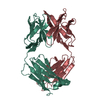 6fabS S: Starting model for refinement |
|---|---|
| Similar structure data |
- Links
Links
- Assembly
Assembly
| Deposited unit | 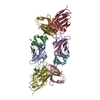
| ||||||||
|---|---|---|---|---|---|---|---|---|---|
| 1 | 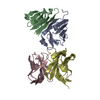
| ||||||||
| 2 | 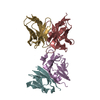
| ||||||||
| Unit cell |
|
- Components
Components
| #1: Protein | Mass: 11893.056 Da / Num. of mol.: 2 / Fragment: ectodomain Source method: isolated from a genetically manipulated source Source: (gene. exp.)   Homo sapiens (human) / Gene: CD3E, T3E / Plasmid: pLM1 / Species (production host): Escherichia coli / Production host: Homo sapiens (human) / Gene: CD3E, T3E / Plasmid: pLM1 / Species (production host): Escherichia coli / Production host:   Escherichia coli BL21(DE3) (bacteria) / Strain (production host): BL21(DE3) / References: UniProt: P07766 Escherichia coli BL21(DE3) (bacteria) / Strain (production host): BL21(DE3) / References: UniProt: P07766#2: Protein | Mass: 9106.425 Da / Num. of mol.: 2 / Fragment: ectodomain Source method: isolated from a genetically manipulated source Source: (gene. exp.)   Homo sapiens (human) / Gene: CD3D, T3D / Plasmid: pLM1 / Species (production host): Escherichia coli / Production host: Homo sapiens (human) / Gene: CD3D, T3D / Plasmid: pLM1 / Species (production host): Escherichia coli / Production host:   Escherichia coli BL21(DE3) (bacteria) / Strain (production host): BL21(DE3) / References: UniProt: P04234 Escherichia coli BL21(DE3) (bacteria) / Strain (production host): BL21(DE3) / References: UniProt: P04234#3: Antibody | Mass: 11994.338 Da / Num. of mol.: 2 Source method: isolated from a genetically manipulated source Source: (gene. exp.)   Mus musculus (house mouse) / Gene: UCHT1 / Plasmid: pET17b / Species (production host): Escherichia coli / Production host: Mus musculus (house mouse) / Gene: UCHT1 / Plasmid: pET17b / Species (production host): Escherichia coli / Production host:   Escherichia coli BL21(DE3) (bacteria) / Strain (production host): BL21(DE3) / References: PIR: PH0888 Escherichia coli BL21(DE3) (bacteria) / Strain (production host): BL21(DE3) / References: PIR: PH0888#4: Antibody | Mass: 13650.221 Da / Num. of mol.: 2 Source method: isolated from a genetically manipulated source Source: (gene. exp.)   Mus musculus (house mouse) / Gene: UCHT1 / Plasmid: pET17b / Species (production host): Escherichia coli / Production host: Mus musculus (house mouse) / Gene: UCHT1 / Plasmid: pET17b / Species (production host): Escherichia coli / Production host:   Escherichia coli BL21(DE3) (bacteria) / Strain (production host): BL21(DE3) / References: PIR: PH0887 Escherichia coli BL21(DE3) (bacteria) / Strain (production host): BL21(DE3) / References: PIR: PH0887#5: Water | ChemComp-HOH / |  Water Water |
|---|
-Experimental details
-Experiment
| Experiment | Method:  X-RAY DIFFRACTION / Number of used crystals: 1 X-RAY DIFFRACTION / Number of used crystals: 1 |
|---|
- Sample preparation
Sample preparation
| Crystal | Density Matthews: 2 Å3/Da / Density % sol: 39.8 % |
|---|---|
Crystal grow | Temperature: 295 K / Method: vapor diffusion, hanging drop / pH: 7 Details: PEG 3350, sodium chloride, HEPES, pH 7.0, VAPOR DIFFUSION, HANGING DROP, temperature 22K |
-Data collection
| Diffraction | Mean temperature: 100 K |
|---|---|
| Diffraction source | Source:  SYNCHROTRON / Site: SYNCHROTRON / Site:  ALS ALS  / Beamline: 8.2.1 / Wavelength: 0.9796 Å / Beamline: 8.2.1 / Wavelength: 0.9796 Å |
| Detector | Type: ADSC QUANTUM 210 / Detector: CCD / Date: Aug 6, 2003 |
| Radiation | Monochromator: Double crystal, Si(111) / Protocol: SINGLE WAVELENGTH / Monochromatic (M) / Laue (L): M / Scattering type: x-ray |
| Radiation wavelength | Wavelength : 0.9796 Å / Relative weight: 1 : 0.9796 Å / Relative weight: 1 |
| Reflection | Resolution: 1.9→50 Å / Num. all: 62308 / Num. obs: 60988 / % possible obs: 97.9 % / Observed criterion σ(F): 0 / Observed criterion σ(I): 0 / Redundancy: 4.9 % / Biso Wilson estimate: 24.8 Å2 / Rmerge(I) obs: 0.065 / Net I/σ(I): 24.4 |
| Reflection shell | Resolution: 1.9→1.97 Å / Redundancy: 5.1 % / Mean I/σ(I) obs: 4.7 / Num. unique all: 6134 / Rsym value: 0.357 / % possible all: 100 |
- Processing
Processing
| Software |
| ||||||||||||||||||||||||||||||||||||||||||||||||||||||||||||||||||||||||||||||||
|---|---|---|---|---|---|---|---|---|---|---|---|---|---|---|---|---|---|---|---|---|---|---|---|---|---|---|---|---|---|---|---|---|---|---|---|---|---|---|---|---|---|---|---|---|---|---|---|---|---|---|---|---|---|---|---|---|---|---|---|---|---|---|---|---|---|---|---|---|---|---|---|---|---|---|---|---|---|---|---|---|---|
| Refinement | Method to determine structure : :  MOLECULAR REPLACEMENT MOLECULAR REPLACEMENTStarting model: PDB ENTRY 6FAB Resolution: 1.9→49.17 Å / Rfactor Rfree error: 0.004 / Data cutoff high absF: 2409958.11 / Data cutoff low absF: 0 / Isotropic thermal model: RESTRAINED / Cross valid method: THROUGHOUT / σ(F): 0 / Stereochemistry target values: Engh & Huber
| ||||||||||||||||||||||||||||||||||||||||||||||||||||||||||||||||||||||||||||||||
| Solvent computation | Solvent model: FLAT MODEL / Bsol: 39.2681 Å2 / ksol: 0.361556 e/Å3 | ||||||||||||||||||||||||||||||||||||||||||||||||||||||||||||||||||||||||||||||||
| Displacement parameters | Biso mean: 30 Å2
| ||||||||||||||||||||||||||||||||||||||||||||||||||||||||||||||||||||||||||||||||
| Refine analyze |
| ||||||||||||||||||||||||||||||||||||||||||||||||||||||||||||||||||||||||||||||||
| Refinement step | Cycle: LAST / Resolution: 1.9→49.17 Å
| ||||||||||||||||||||||||||||||||||||||||||||||||||||||||||||||||||||||||||||||||
| Refine LS restraints |
| ||||||||||||||||||||||||||||||||||||||||||||||||||||||||||||||||||||||||||||||||
| LS refinement shell | Resolution: 1.9→2.02 Å / Rfactor Rfree error: 0.012 / Total num. of bins used: 6
| ||||||||||||||||||||||||||||||||||||||||||||||||||||||||||||||||||||||||||||||||
| Xplor file |
|
 Movie
Movie Controller
Controller



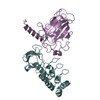

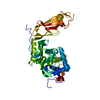

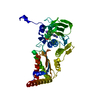

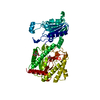
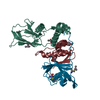

 PDBj
PDBj









